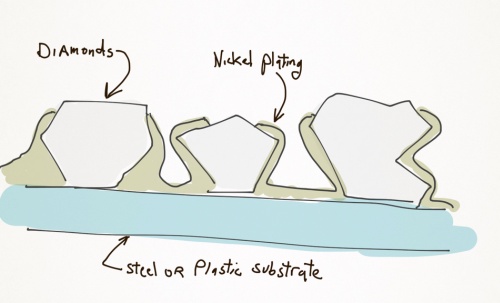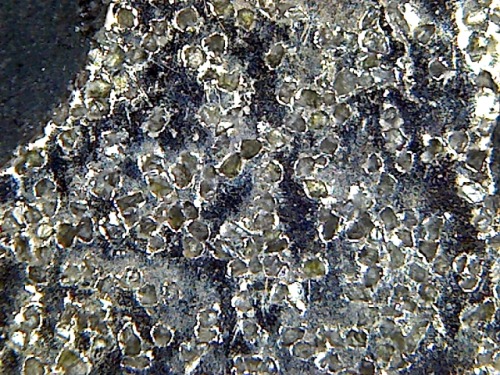 In the past 30 years sharpening with diamond stones has gotten more and more popular. Some teachers, notably Paul Sellers have been huge advocates of the technology, and more and more people are using diamonds for some of all or their hand sharpening needs. The largest US maker of diamond stones for sharpening, and one of the best is DMT and lately we have started to stock most of their entire range. This is the first of two blogs on diamond sharpening, this entry being about the issues involved, and the next part about with my personal experiences with the stuff. In the past 30 years sharpening with diamond stones has gotten more and more popular. Some teachers, notably Paul Sellers have been huge advocates of the technology, and more and more people are using diamonds for some of all or their hand sharpening needs. The largest US maker of diamond stones for sharpening, and one of the best is DMT and lately we have started to stock most of their entire range. This is the first of two blogs on diamond sharpening, this entry being about the issues involved, and the next part about with my personal experiences with the stuff.
30 years ago the major complaints about diamond stones were that the stones weren't flat enough for precision sharpening, the stones didn't last, and you could not get a finished edge from one. The major positives about the technology were that the rise of exotic alloys in woodworking tools such as A2 and D2 increased the demand for a sharpening media what could handle these tough materials with speed. Also diamond stones didn't need lubrication or flattening.
Another popular application of diamonds in sharpening is to charge a plate with diamond paste, which turns the plate into a fine abrasive stone. This works great,especially for very fine grits. This is an old method of sharpening that has been applied to woodworking tools for the past ten or twenty years.
In addition to directly sharpening stones another very popular use of diamond stones is to flatten waterstones. It's a quick method and works great with one major problem. The problem is that the way you make a diamond stone is by taking a flat piece of steel, sprinkling diamond dust of a specific grade on the plate, and then nickel plating the entire plate, rocks and all, to cover the stone. The plating bonds the diamonds to the plate. When you use a diamond stone to flatten a waterstone, the water stone particles are abrasive and wear away the the plating that keeps the diamonds on the stone - so the diamond stones work slower and slower. In the photo (taken with my inexpensive not very sharp USB microscope) on the right you can see the plating surrounding the diamond particles like irregular halos.
When sharpening diamonds produce a coarser edge than does the same grit waterstone. There are two reasons for this. Diamonds, like most abrasives have a nominal grit assigned to the stone. The grit - 220, 600, or 1200 or so mesh is the maximum size of the diamond particle. This is the same with all abrasive stones - there is a nominal abrasive grade and an actual variance on the particles. Lower quality stones will have a greater grit variance but all diamond stones have some variance. With regular waterstones the second you start sharpening, any large grit particle shatters, and all the particles start to round over and wear. So very quickly you get an even scratch pattern that we associate with the grit of stone. Diamonds, which cut fast, don't shatter (very much) and the larger diamonds on plate scratch the edge deeper, and don't get worn down. The end result is that for the same grit stone, the diamond scratch pattern is a fair amount coarser. But, because the diamonds don't break down, very fine diamond pastes can sharpen quickly and for a long time.
Pre-diamond my basic sharpening sequence for waterstones was, Hollow grind, use a 1000 grit stone to create the wire edge, then chase it with first a 4000 or 5000 stone, followed by an 8000 grit or better finishing stone. For harder Japanese tools I stop there, for Western steels which are typically softer I follow with a plain, untreated leather strop.
The question now is what's an appropriate sequence of diamond stones? Do I need as many? of what size? DMT makes two basic styles: the original DuoSharp with spots of diamonds on plastic substrate, and the DiaSharp which is a continuous diamond surface on a precisely flattened steel substrate. For woodworking tools the steel plate is the way to go - it's what they were designed for. They do weigh a ton, are more expensive than the earlier stones, and are overkill for knives and other non-precision tools. I like large stones, but the weight of the steel stones has kept me on the 8" size, not the 10". A fair number of customers like the 6" length because it's a lot less expensive, and much lighter. To keep the stones from slipping around a bench we stock the absolutely fab non-skid mat or a magnetic holder that comes with 12" stones and has the advantage of lifting the stone off the bench for more clearance.
DMT does manufacturer, and we offer, an 8000 grit (extra-extra-fine) DiaSharp, but as I am chock full of finishing stones I haven't tested it. In the next part of this series I will take a closer look at diamonds and start getting into practical experiences. I've got two goals here - the first is figure out if I can get an edge that is the equal to or better of the edges I get using oil or water stones. The next goal is to figure out what's the fastest way of getting there. Finally, and make that three or four goals, can diamonds be used on my carving tools and are they an improvement on what I am already using? The last goal and let's just say, amongst my many goals, is answering the question: are diamonds a good solution for sharpening kitchens knives and other things that I get regularly asked to sharpen?
Click here for Part Two
|
 Joel's Blog
Joel's Blog Built-It Blog
Built-It Blog Video Roundup
Video Roundup Classes & Events
Classes & Events Work Magazine
Work Magazine


 In the past 30 years sharpening with diamond stones has gotten more and more popular. Some teachers, notably
In the past 30 years sharpening with diamond stones has gotten more and more popular. Some teachers, notably 
Thank you. You consistently deal with issues which directly impact our lives as woodworkers, providing thoughtful and well founded advice and suggestions. You help all of us learn and grow in the experience which we all enjoy, working with wood.
Thanks,
Mark
So, I will stick with the excellent micro-abrasive 3M paper that I get from TGWW to do the final polishing on my planes and chisels. The results are fantastic.
I've abandoned strop honing on leather due to rounding and adopted 3M's 0.5 micron PSA film on float glass instead. Uber sharp!
I've abandoned strop honing on leather due to rounding and adopted 3M's 0.5 micron PSA film on float glass instead. Uber sharp!
Great question. the slurry wears away the plating. There might be some wear on the diamonds but I am pretty sure it's the plating. I have a plate I can't find at the moment which would show this one way or another. There also might be a point at which depending on the diamond shape, the wear on the nickel doesn't loosen the diamonds. Many people use diamond flattening plates, they work great, and even if they slow down they are still useable years later.
A coarse plate we use for steel only is about 7 years old and going very strong.
I recall one of the DMT guys saying a while back that it depends on the diamond grit, because the nickel plating is different on fine vs. coarse stones: Using a fine grit plate as a waterstone flattener will wear it out, while a coarse grit plate will keep working indefinitely.
The big Dia-Flat lapping plates are obviously designed to explicitly withstand use as a waterstone flattener.
I do use it for all my kitchen knives, too, and it works very well. I just hone each bevel on the diamond stone until I get a wire edge and then use a sharpening steel to smooth it all out.
One question about the cool sounding MagnaBase is whether the magnetic pull is enough to make the tools to be sharpened, stick to the plate with any meaningful pull? Will it cause the sharpening action to possibly feel stilted?